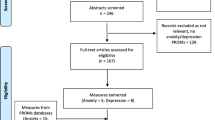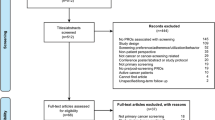Abstract
Purpose
Scan-associated anxiety (‘scanxiety’) is a problem for people with advanced cancer. We aimed to determine the prevalence, severity and associations of scanxiety in this population.
Methods
People with advanced cancer and a computed tomography scan within the last 4 months completed a multicentre survey including self-rated presence (yes/no) and severity (distress thermometer, 0–10) of scanxiety, state anxiety (STAI-6), clinical anxiety and depression (HADS), and fear of progression (FOP-Q-SF). Associations with scanxiety were evaluated.
Results
There were 222 participants: mean age 64 years (range 26 to 91), female (61%), most common cancer types (breast 37%, lung 19%, colorectal 16%) and > 1 year since cancer diagnosis (82%). Sixty-two percent had a scan within the last month, and 70% reported waiting > 2 days for the result. Over half (55%) of participants experienced scanxiety. On multivariable analysis, scanxiety was more prevalent in participants who were younger (mean age 62 years with v 66 years without scanxiety, p = 0.02) and more remote (v major city, OR 2.6, p = 0.04). Among participants with scanxiety, the mean severity score was 6 (range 1–10) with peak severity occurring when waiting for scan results. On multivariable analysis, scanxiety was 1.2 points higher in participants who had been diagnosed within the past year (v > 1 year, p = 0.04) and was higher in participants who had higher STAI-6 scores (β = 0.06, p = 0.004).
Conclusion
Scanxiety is common and can be severe. Strategies to reduce scanxiety are needed.

Similar content being viewed by others
Availability of data and material
Data from this study are available in the article and its online supplementary material.
Code availability
Not applicable.
References
Feiler B (2011) Scanxiety. Time 177
Dana-Farber Cancer Institute (2019) Scan Anxiety (or ‘Scanxiety’): 5 approaches to coping. https://blog.dana-farber.org/insight/2019/02/5-tips-for-reducing-scanxiety/. Accessed May 2020
Memorial Sloan Kettering (2013) Coping with “scanxiety” during and after cancer treatment. https://www.mskcc.org/blog/coping-scanxiety-during-and-after-treatment/. Accessed May 2020
Wiedemann K (2001) Anxiety and anxiety disorders. In: Smelser NJ, Baltes PB (eds) International encyclopedia of the social & behavioral sciences. Pergamon: Elsevier Ltd, pp 560–567. https://doi.org/10.1016/B0-08-043076-7/03760-8
Bui KT, Liang R, Kiely BE, Brown C, Dhillon HM, Blinman P (2021) Scanxiety: a scoping review about scan-associated anxiety. BMJ Open 11(5):e043215. https://doi.org/10.1136/bmjopen-2020-043215
Bauml JM, Troxel A, Epperson CN, Cohen RB, Schmitz K, Stricker C, Shulman LN, Bradbury A, Mao JJ, Langer CJ (2016) Scan-associated distress in lung cancer: quantifying the impact of “scanxiety.” Lung Cancer 100:110–113. https://doi.org/10.1016/j.lungcan.2016.08.002
Bui KT, Blinman P, Kiely BE, Brown C, Dhillon HM (2021) Experiences with scans and scanxiety in people with advanced cancer: a qualitative study. Support Care Cancer. https://doi.org/10.1007/s00520-021-06319-1
Ownby K (2019) Use of the distress thermometer in clinical practice. J Adv Pract Oncol 10(2). https://doi.org/10.6004/jadpro.2019.10.2.7
Powers BJ, Trinh JV, Bosworth HB (2010) Can this patient read and understand written health information? J Am Med Assoc 304(1):76–84. https://doi.org/10.1001/jama.2010.896
Marteau TM, Bekker H (1992) The development of a six-item short-form of the state scale of the Spielberger State-Trait Anxiety Inventory (STAI). Br J Clin Psychol 31:301–306. https://doi.org/10.1111/j.2044-8260.1992.tb00997.x
Zigmond AS, Snaith RP (1983) The hospital anxiety and depression scale. Acta Psychiatr Scand 67(6):361–370. https://doi.org/10.1111/j.1600-0447.1983.tb09716.x
Herschbach P, Berg P, Dankert A, Duran G, Engst-Hastreiter U, Waadt S, Keller M, Ukat R, Henrich G (2005) Fear of progression in chronic diseases: psychometric properties of the Fear of Progression Questionnaire. J Psychosom Res 58(6):505–511. https://doi.org/10.1016/j.jpsychores.2005.02.007
Mehnert A, Herschbach P, Berg P, Henrich G, Koch U (2006) Progredienzangst bei Brustkrebspatientinnen - Validierung der Kurzform des Progredienzangstfragebogens PA-F-KF. Z Psychosom Med Psychother 52(3)
R Core Team (2019) R: A language and environment for statistical computing. R Foundation for Statistical Computing. Vienna
Australian Government (2011) Accessibility Remoteness Index of Australia (ARIA) review analysis of areas of concern – final report. Canberra
Derry HM, Maciejewski PK, Epstein AS, Shah MA, LeBlanc TW, Reyna V, Prigerson HG (2019) Associations between anxiety, poor prognosis, and accurate understanding of scan results among advanced cancer patients. J Palliat Med 22(8):961–965. https://doi.org/10.1089/jpm.2018.0624
Morreale MK, Moore TF, Kim S, Uphold HS, Mabunda LM, Harper FWK (2020) Preferences for notification of imaging results in patients with metastatic cancer. Patient Educ Couns 103(2):392–397. https://doi.org/10.1016/j.pec.2019.08.032
Pitman A, Suleman S, Hyde N, Hodgkiss A (2018) Depression and anxiety in patients with cancer. BMJ 361:k1415. https://doi.org/10.1136/bmj.k1415
Sun H, Yang Y, Zhang J, Liu T, Wang H, Garg S, Zhang B (2019) Fear of cancer recurrence, anxiety and depressive symptoms in adolescent and young adult cancer patients. Neuropsychiatr Dis Treat 15:857–865. https://doi.org/10.2147/NDT.S202432
Hefner J, Berberich S, Lanvers E, Sanning M, Steimer AK, Kunzmann V (2017) New insights into frequency and contents of fear of cancer progression/recurrence (FOP/FCR) in outpatients with colorectal carcinoma (CRC) receiving oral capecitabine: a pilot study at a comprehensive cancer center. Patient Prefer Adherence 11:1907–1914. https://doi.org/10.2147/PPA.S142784
Goebel S, Mehdorn HM (2019) Fear of disease progression in adult ambulatory patients with brain cancer: prevalence and clinical correlates. Support Care Cancer 27(9):3521–3529. https://doi.org/10.1007/s00520-019-04665-9
Acknowledgements
We acknowledge the contribution of patients involved in this study, from Concord Repatriation General Hospital, Campbelltown Hospital, Dubbo Base Hospital and Breast Cancer Network Australia (BCNA) Review and Survey Group. We also acknowledge the support from the Psycho-Oncology Co-operative Research Group.
Author information
Authors and Affiliations
Contributions
KTB, BEK, HMD, PB and CB contributed to the study conception and design. Recruitment and survey distribution was performed by KTB, BEK, KX, MS and PB. Data analysis was performed by KTB and CB. The first draft of the manuscript was written by KTB and all authors reviewed and edited the manuscript. All authors read and approved the final manuscript.
Corresponding author
Ethics declarations
Ethics approval
This study was approved by the Sydney Local Health District Human Research Ethics Committee—Concord Repatriation General Hospital (2019/ETH8007). The study was performed in accordance with the ethical standards laid down in the 1964 Declaration of Helsinki and its later amendments. Reporting followed the Strengthening the Reporting of Observational Studies in Epidemiology (STROBE) Statement.
Consent to participate
Informed consent was implied by return of the survey.
Consent for publication
Not applicable.
Conflict of interest
Financial interests: BEK reports receipt of honoraria for advisory boards and educational presentations as well as travel and meeting expenses from Roche, receipt of honoraria for educational presentations from Novartis. HMD reports honoraria paid to their institution for educational presentations from MSD and BMS and advisory board by MSD. KTB, PB and CB declare they have no relevant financial interests to disclose.
Additional information
Publisher's note
Springer Nature remains neutral with regard to jurisdictional claims in published maps and institutional affiliations.
Supplementary Information
Below is the link to the electronic supplementary material.
Rights and permissions
About this article
Cite this article
Bui, K.T., Kiely, B.E., Dhillon, H.M. et al. Prevalence and severity of scanxiety in people with advanced cancers: a multicentre survey. Support Care Cancer 30, 511–519 (2022). https://doi.org/10.1007/s00520-021-06454-9
Received:
Accepted:
Published:
Issue Date:
DOI: https://doi.org/10.1007/s00520-021-06454-9




